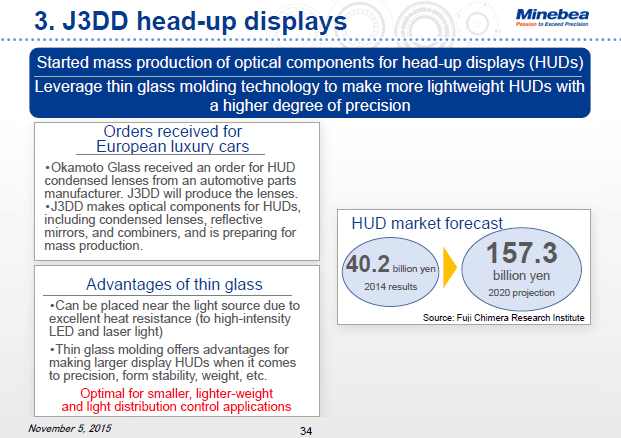Presentation Transcripts
Latest Update : Nov.25, 2015
Back to Financial Results (FY3/2016)
Investor Meeting Presentation for 2Q FY 3/2016 held on November 5, 2015
- Cover
- Table of contents
- Financial Results
- Summary of Consolidated Business Results for 1H
- Summary of Consolidated Business Results for 2Q
- Net Sales
- Operating Income
- Machined Components Business
- Electronic Devices & Components Business
- Net Income
- S.G. & A. Expenses
- Inventories
- Capital Expenditure & Depreciation
- Net Interest-Bearing Debt
- Forecast for Fiscal Year Ending March 31, 2016
- Forecast for Business Segment
- Policy and Strategy
- Table of Contents
- Current Performance and Minebea Share Price - 1
- Current Performance and Minebea Share Price - 2
- Our View on Current Market Conditions
- Our View on Future Business Risks
- 1. Efforts to keep next year's market share for LED backlights
- 2. OLED displays will not replace all high-end smartphone LCDs in 3 years
- 3-1. Profits do not decline by HDD volume down (Future of Ball Bearings and Pivot Assemblies)
- 3-2. Profits do not decline by HDD volume down (Future of HDD spindle motors)
- 4-1. Measuring Components business to become a growth driver this year, next and one after next
- 4-2. Motor business to become a growth driver this year, next and one after next
- Unforeseen Factors behind First Half Performance
- Outlook for this Fiscal Year
- New Mid-term Business Plan targets
- Future Developments (New Products)
- 1. Smart City Project in Cambodia
- 2. SALIOT™ (Smart Adjustable Light for IoT)
- 3. J3DD head-up displays
- Dividend Forecast
- M&A and Alliance Strategies
- Forward-looking Statements
J3DD, which joined the Minebea Group last year, is a joint venture with Okamoto Glass that started out making optical components for in-vehicle head-up displays (HUDs. We asked Okamoto Glass to design collimating and condensed lenses that go between the LED and LCD so that an image can be projected when the LED light is shone onto a display. They have been adopted for use in a leading European manufacturer's HUDs and the first batch has already been shipped. Here's the reason why we are focusing on J3DD's glass components. HUDs currently use high-intensity LED or laser as a light source. Traditionally plastic has been chiefly used for reflecting, reducing, or magnifying lenses. While HUDs will become increasingly larger, there are two obstacles standing in the way of plastic. One is heat. When exposed to high-intensity LED or laser light, a plastic lens will deform due to the heat, resulting in a distorted image. Another problem is the fact that the blue beams of LED or laser light degrades and discolors plastic over time. There are limitations to plastic if you want to make reliable products. That's why we believe glass is a better fit for applications like this.
We started out making collimating lenses and are now working to boost sales with a line of glass products, including HUD mirrors and combiners. Other in-vehicle applications include headlamps, which increasingly employ LED lights. They have become very sophisticated and now employ an extremely complex mechanism. Those fitted to European luxury cars use a very large lens to distribute light. If we make them with thin, durable glass, we should eventually be able to make inroads into this market. Headlamps used to all be made of glass but were ultimately replaced by plastic. We're now keeping an eye on the possibility that manufacturers may go back to glass as we move forward with R&D efforts.
35page (total 38pages)
![]() You need Adobe Reader® to view these documents. Click on Adobe Reader icon on the left to download the software from the Adobe Systems website.
You need Adobe Reader® to view these documents. Click on Adobe Reader icon on the left to download the software from the Adobe Systems website.
It ends about main text.












